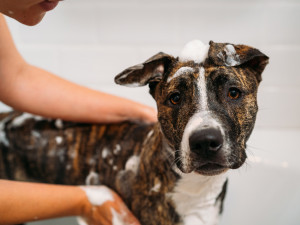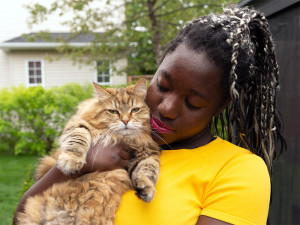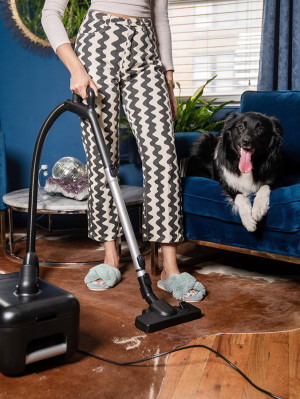The Best Hypoallergenic Dog Breeds
No dog is allergen-free, but some breeds may spare you from constant sneezing.
In This Article:
What Are Hypoallergenic Dogs? What Factors Make a Dog Hypoallergenic? The Best Hypoallergenic Dog Breeds Are Any Breeds Truly Hypoallergenic? Tips for Managing Allergies With Dogs Frequently Asked Questions
If being around a dog makes you sniffle and sneeze, you aren’t alone. A huge portion of people in the United States — as many as 10 to 20 percentopens in new tab — suffer from pet allergies. But that hasn’t stopped many from becoming pet parents themselves, so don’t give up on your dreams of puppy parenthood just yet.
Contrary to popular belief, dog allergies aren’t just a reaction to fur, but to saliva, urine, and dander, all of which can cause responses in allergy sufferers. And while there are no 100 percent allergen-free dogsopens in new tab, some breeds may cause fewer allergy issues than others.
Best of all, you don’t need to drop several thousand dollars on an expensive breeder to find the best hypoallergenic dogs. Many shelters and rescues are filled with so-called “designer dogs” looking for loving homes, and you could be the one to provide a pup’s happy ending. Unfortunately, you can also find many Doodle breeds who have been rescued from backyard breeders and desperately need safe homes.
What are hypoallergenic dogs?
The term “hypoallergenic” refers to dogs (and cats) who produce fewer allergens and may be a better fit for pet allergy sufferers. A hypoallergenic dog is not allergen-free and may still cause an allergic reaction. Each person has their own level of reactivity, which can vary from breed to breed and even from dog to dog.
That said, specific purebred dogs are more likely to be �“hypoallergenic” and may be better pets for people with dog allergies. But even if you do adopt one of these breeds, you will still have to take steps to prevent allergic reactions.
What factors make a dog “hypoallergenic”?
While all dogs produce allergensopens in new tab in their dander, urine, and saliva, some dogs may be far less likely to set off an allergic reaction. This can be because they shed less or because their coat traps dander instead of releasing it into the air. But even if a dog doesn’t produce significant dander, they may still have allergens on their skin or in their saliva or urine, which can lead to coughing, sneezing, and itching for humans with pet allergies.
Low-shedding
Some dogs shed much less than others, producing less dander. Dander clings to pet hair and is the cause of most dog allergies in humans. If you’re looking for a dog who won’t aggravate your allergies as much, consider a low-shedding breed.
Coat type
While you may think that short-haired dogs have fewer allergens than long-haired breeds, it often depends on the breed and the type of coat a dog has. Some breeds, like Poodles, have hair instead of fur, which tends to trap the dander they release and prevent it from entering the environment — and potentially causing an allergic reaction.
Saliva and dander production
Some dog breedsopens in new tab simply produce less salivaopens in new tab and dander than others, which makes them less likely to trigger an allergic response.
The best hypoallergenic dog breeds
So, what dogs are hypoallergenic? While no dog is completely allergen-free, certain dog breeds tend to produce less dander and may be better pets for those with pet allergies. Below is a list of “hypoallergenic” dogs that often release less dander and other allergens into the air. Make sure to thoughtfully consider what dog breed is right for youopens in new tab.
Poodle
The Poodle’s curly hair — not fur — prevents some of the dander they produce from releasing into the air. Plus, Poodles also don’t shed as much as many other dogs, making this intelligent and active breed a great fit for allergy sufferers.
Labradoodle and Goldendoodle
If you’re looking for large hypoallergenic dogs, consider Doodles. Mixed with Poodles to create a more-allergy friendly breed, Labradoodles (Labrador and Poodle) and Goldendoodles (Golden Retriever and Poodle) are some of the most popular hypoallergenic breeds.
Bichon Frisé
This small and fluffy breed doesn’t shed at all but requires regular grooming and haircuts to maintain their coats. If you live in an apartment or small spaceopens in new tab, the Bichon Frisé may be an excellent option.
Shih Tzu
Are Shih Tzu dogs hypoallergenic? Another small breed, the Shih Tzu is known for their friendly nature and thick coat, which traps much of the allergy-activating dander. Just keep in mind that this breed’s flat face may make it more prone to health issues, like overheating and respiratory problems.
Schnauzer (Miniature, Standard, Giant)
All three Schnauzer breeds have similar coats that make them good choices for people with pet allergies. As with any dog, be aware of their particular grooming and exercise needs to keep them happy and healthy.
Maltese
One of the most popular small hypoallergenic dogs, the Maltese has long, silky hair, the Maltese is a surprising option for allergy sufferers. Like many of the dogs on this list, they require daily brushing to maintain their coats.
Are any breeds truly hypoallergenic?
Do hypoallergenic dogs exist? No dog breed is truly hypoallergenic, in the sense that they don’t cause allergic reactions. However, some dogs may trigger fewer allergic responses, making them better choices for people with allergies.
Tips for managing allergies with dogs
If you have a dog allergy, you’ll need to keep your home and your pet clean to prevent allergic reactions. Below are a few tips for managing your allergies when you have a dog in the home:
Frequently launder your pet’s bedding.
Maintain a regular grooming schedule for your dog.
Consider not allowing your dog on your bed or other furniture.
Say goodbye to any heavy carpets or drapes that can trap dander.
Invest in air purifiers to help remove allergens from the air and vacuum cleaners designed for pet hair.
FAQs (People also ask):
How do I know if I’m allergic to dogs?
Symptoms of a pet allergyopens in new tab tend to show up when you’re around dogs. They can include:
Sneezing
Runny or congested nose
Coughing, wheezing, or shortness of breath
Itchy, watery, or red eyes
A rash or hives
To determine if dogs are the source of your allergic reaction, visit an allergist, who can perform a test to see what causes your allergies.
What is the best family hypoallergenic dog to adopt?
Poodles and Doodles, such as Goldendoodles and Labradoodles, tend to be great with kids and love to play. Portuguese Water Dogs are also active family dogs and became more popular after the Obama family adopted this breed. Having a dog in the home can even help reduce the risk of asthmaopens in new tab and other health issues in some children.
What should I do if my partner is allergic to my dog?
If your partner turns out to be allergic to your dog (and you really don’t want to break up), work to keep pet dander under control in your home by regularly brushing and grooming your dog. You may also want to establish an area in the home where your pet is not allowed, such as the bedroom. Air purifiers can also help to remove dander and other allergens from the environment.











